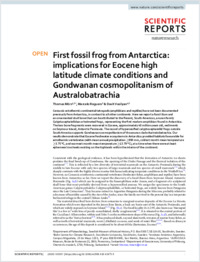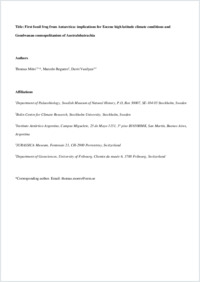First fossil frog from Antarctica: implications for Eocene high latitude climate conditions and Gondwanan cosmopolitanism of Australobatrachia
Université de Fribourg
- Mörs, Thomas Swedish Museum of Natural History and Stockholm University, Sweden
- Reguero, Marcelo Instituto Antártico Argentino (Buenos Aires), Argentina
- Vasilyan, Davit JURASSICA Museum (Porrentruy) and University of Fribourg, Switzerland
-
23.04.2020
Published in:
- Scientific Reports. - 2020, vol. 10, p. 5051
English
Cenozoic ectothermic continental tetrapods (amphibians and reptiles) have not been documented previously from Antarctica, in contrast to all other continents. Here we report a fossil ilium and an ornamented skull bone that can be attributed to the Recent, South American, anuran family Calyptocephalellidae or helmeted frogs, representing the first modern amphibian found in Antarctica. The two bone fragments were recovered in Eocene, approximately 40 million years old, sediments on Seymour Island, Antarctic Peninsula. The record of hyperossified calyptocephalellid frogs outside South America supports Gondwanan cosmopolitanism of the anuran clade Australobatrachia. Our results demonstrate that Eocene freshwater ecosystems in Antarctica provided habitats favourable for ectothermic vertebrates (with mean annual precipitation ≥900 mm, coldest month mean temperature ≥3.75 °C, and warmest month mean temperature ≥13.79 °C), at a time when there were at least ephemeral ice sheets existing on the highlands within the interior of the continent.
- Faculty
- Faculté des sciences et de médecine
- Department
- Département de Géosciences
- Language
-
- English
- Classification
- Palaeontology
- License
- License undefined
- Identifiers
-
- RERO DOC 328372
- DOI 10.1038/s41598-020-61973-5
- Persistent URL
- https://folia.unifr.ch/global/documents/308566
Other files
Statistics
Document views: 57
File downloads:
- Vasilyan_2020_First_main.pdf: 105
- Vasilyan_2020_First_supplement.pdf: 111

